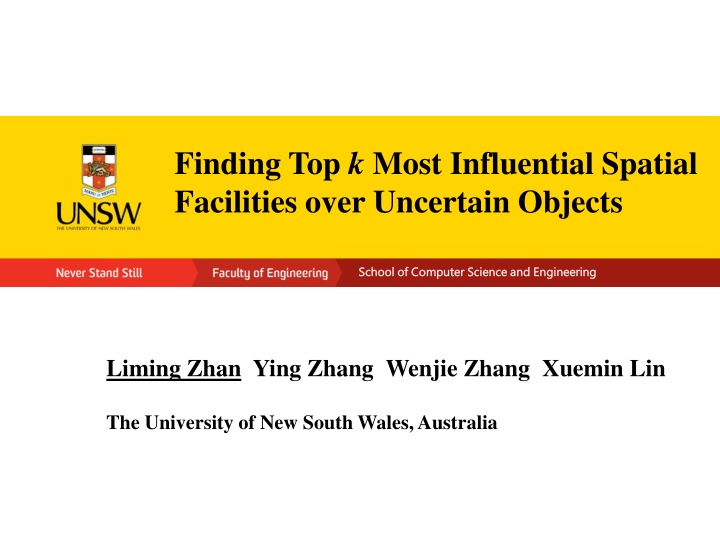
Finding Top Influential Spatial Facilities over Uncertain Objects
"Explore how to identify the most influential spatial facilities over uncertain objects in computer science and engineering, with a focus on areas such as warehouse management systems and location-based services. Uncertainty models and challenges in analyzing influential sites are discussed, along with motivating examples and problem statements."
Download Presentation

Please find below an Image/Link to download the presentation.
The content on the website is provided AS IS for your information and personal use only. It may not be sold, licensed, or shared on other websites without obtaining consent from the author. If you encounter any issues during the download, it is possible that the publisher has removed the file from their server.
You are allowed to download the files provided on this website for personal or commercial use, subject to the condition that they are used lawfully. All files are the property of their respective owners.
The content on the website is provided AS IS for your information and personal use only. It may not be sold, licensed, or shared on other websites without obtaining consent from the author.
E N D
Presentation Transcript
Finding Top k Most Influential Spatial Facilities over Uncertain Objects School of Computer Science and Engineering School of Computer Science and Engineering Liming Zhan Ying Zhang Wenjie Zhang Xuemin Lin The University of New South Wales, Australia
Outline Motivation Problem Definition Our Approach Experiments Conclusion 1
Motivation example: NN, RNN, Influential Sites I(F1)=1 I(F2)=2 I(F3)=0 I(F): influence score of F, which is the number of objects influenced by F, namely, treat F as the NN. 2
Motivation Warehouse Management Systems RFID tags are attached to the items, whose locations can be obtained by RFID readers Find top k populardispatching points. Location Based Service (LBS) Mobile to identify users location Find the top k supermarkets which influence the largest number of users. 3
Influence Sites Influence sets based on reverse nearest neighbor queries [SIGMOD 2000, Korn et al.] On computing top-t most influential spatial sites (TkIS) [VLDB 2005, Xia et al.] 4
Uncertainty exists Uncertainty RFID Reader: noisy Location of mobile users: imprecise Uncertain objects Continuous: PDF Discrete: multiple instances 5
Challenge Uncertain model Instances from an uncertain object may be influenced by several facilities How to model the query. Efficiency of the algorithm More complicated than that of traditional objects 7
Example [TKDE 2011, Zheng et al.] 8
Problem Statement Given a set of uncertain objects O and a set of facilities F, find the k facilities with the highest expected influence scores. 9
Nave method For each instance of an object, find the nearest facility f and increase the influential score of f by the probability of the instance. Return k facilities with highest scores. 10
Data Structure: Global R-tree Global R-tree indexes the MBBs of all uncertain objects. MBB of an object is the minimum bounding box containing all its instances. Each leaf is a MBB of an object in the global R- tree. 11
Data Structure: Local aR-tree (Aggregate R-tree) For each uncertain object, a local aR-tree is built to organize its multiple instance. For every intermediate entry E in the local aR-tree, the probability of E is the sum of probability of the instances considering E as an ancestor. P(E)=P(E1)+P(E2) 12
Framework Filtering Obtain tight lower and upper bounds for each facility and prune unpromising facilities. Process on global index - no object loaded. Refinement For each candidate facility, compute influence score based on local aR-tree. 13
Filtering: Level by level RU: Objects R-tree RF: Facility R-tree 14
Filtering: upper bound of facility score min distance max distance maxdist(F1,E1)< mindist(Fi,E1) I+(F1), I+(F2) number of objects in E1 maxdist(F2,E1)< mindist(Fi,E1) 15
Filtering: lower bound of facility score max distance min distance maxdist(F1,E1)< mindist(F2,E1) I-(F1) number of objects in E1 maxdist(F1,E1)< mindist(F3,E1) 16
Filtering: get candidate Sort facilities by lower bound in descending order For top-K query Compare the lower bound of the Kthfacility with the upper bound of the following facilities Get candidate facilities dataset 17
Refinement For each candidate facility, traverse all the possible influenced objects aR-tree to get the exact score. Get the top k facilities with the highest influence scores. 18
U-Quadtree as global index EDBT 2012, Zhang et al. 19
Improvement by U-Quadtree Filtering U-Quadtree build summaries of objects based on Quadtree, so we can get tighter upper and lower bounds to prune more objects. Refinement Use the leaf cell of U-Quadtree to intersect the entries of aRtree to reduce the search space. 20
Experiments Algorithms: Na ve: The na ve implementation RTKIS: The technique based on R-tree UQuadTKIS: The technique based on U-Quadtree UTKIS: The technique presented in [TKDE 2011, Zheng et al.] Environment: PC with Intel Xeon 2.40GHz dual CPU 4GB memory Debian Linux Disk page size is 4096 bytes 21
Experiments (Cont.) Real datasets Center distribution: CA (62k), US (200k), R-tree-portal(21K) Normalized to [0,10000] Parameters 22
Experiments (Cont.) Expected Score VS Expected Rank Result Comparison 23
Experiments (Cont.) Impact of Data Distribution 24
Experiments (Cont.) Varying m Varying ru Varying #facilities Varying #objects 25
Conclusion We propose a new model to evaluate the influences of the facilities over a set of uncertain objects. Efficient R-tree and U-Quadtree based algorithms are presented following the filtering and refinement paradigm. Novel pruning techniques are proposed to significantly improve the performance of the algorithms by reducing the number of uncertain objects and facilities in the computation. Comprehensive experiments demonstrate the effectiveness and efficiency of our techniques. 26
